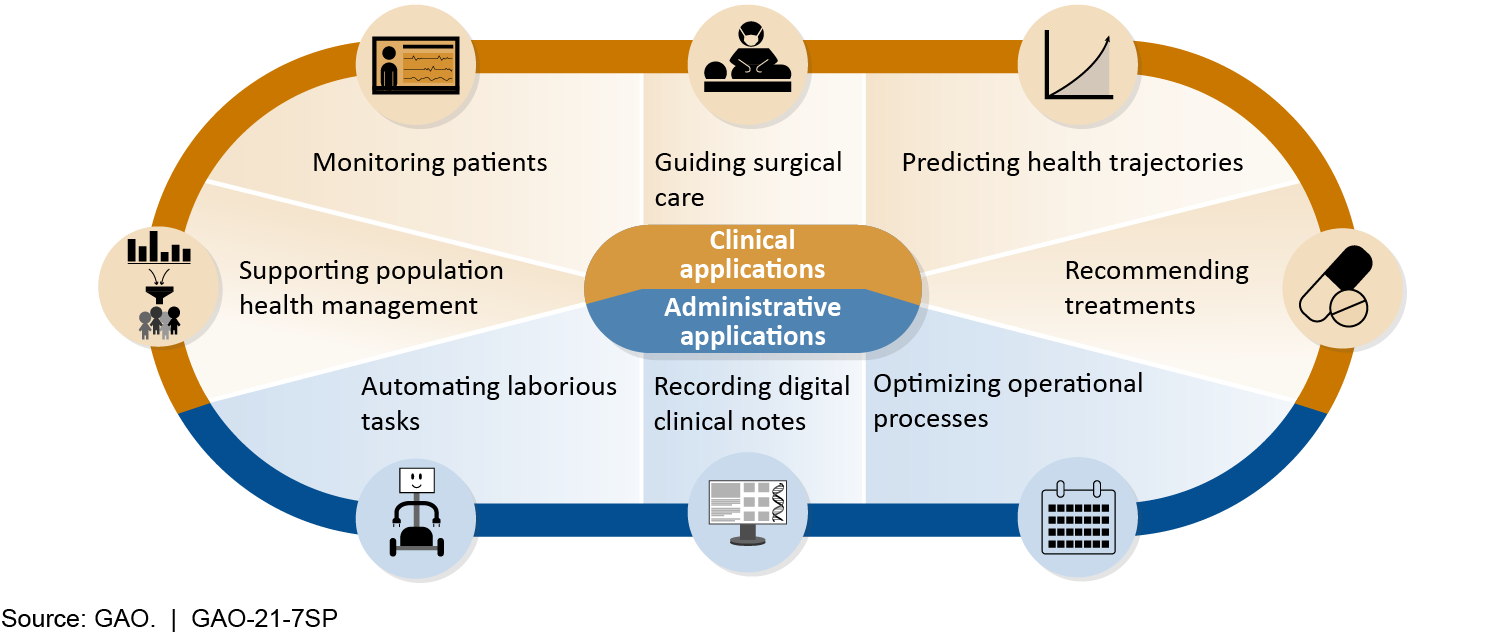Artificial Intelligence in Health Care. Benefits and Challenges of Technologies to Augment Patient Care
This report is being jointly published by the Government Accountability Office (GAO) and the National Academy of Medicine (NAM). Part One of this joint publication is the full presentation of GAO’s Technology Assessment: Artificial Intelligence in Health Care: Benefits and Challenges of Technologies to Augment Patient Care. Part Two is the full presentation of NAM’s Special Publication: Advancing Artificial Intelligence in Health Settings Outside the Hospital and Clinic.
Policy Options to Address Challenges or Enhance Benefits of AI to Augment Patient Care
| Policy Option | Opportunities | Considerations |
Collaboration (report p. 32)
Policymakers could encourage interdisciplinary collaboration between developers and health care providers.
| - Could result in AI tools that are easier to implement and use within a providers’ existing workflow.
- Could help implement tools on a larger scale.
- Approaches to encourage collaboration include agencies seeking input from innovators. For example, agencies have used a challenge format to encourage the public to develop innovative technologies.
| - May result in the creation of tools that are specific to one hospital or provider.
- Providers may not have time to both collaborate and treat patients.
|
Data Access (report p. 33)
Policymakers could develop or expand high-quality data access mechanisms.
| - A “data commons”–a cloud based-platform where users can store, share, access, and interact with data–could be one approach.
- More high-quality data could facilitate the development and testing of AI tools.
- Could help developers address bias concerns by ensuring data are representative, transparent and equitable.
| - Cybersecurity and privacy risks could increase, and threats would likely require additional precautions.
- Would likely require large amounts of resources to successfully coordinate across different domains and help address interoperability issues.
- Organizations with proprietary data could be reluctant to participate.
|
Best Practices (report p. 34)
Policymakers could encourage relevant stakeholders and experts to establish best practices (such as standards) for development, implementation, and use of AI technologies.
| - Could help providers deploy AI tools by providing guidance on data, interoperability, bias, and implementation, among other things. Could help improve scalability of AI tools by ensuring data are formatted to be interoperable.
- Could address concerns about bias by encouraging wider representation and transparency.
| - Could require consensus from many public- and private-sector stakeholders, which can be time- and resource-intensive.
- Some best practices may not be widely applicable because of differences across institutions and patient populations.
|
Interdisciplinary Education (report p. 35)
Policymakers could create opportunities for more workers to develop interdisciplinary skills.
| - Could help providers use tools effectively.
- Could be implemented in a variety of ways, including through changing academic curriculums or through grants.
| - Employers and university leaders may have to modify their existing curriculums, potentially increasing the length of medical training.
|
Oversight Clarity (report p. 36)
Policymakers could collaborate with relevant stakeholders to clarify appropriate oversight mechanisms.
| - Predictable oversight could help ensure that AI tools remain safe and effective after deployment and throughout their lifecycle.
- A forum consisting of relevant stakeholders could help recommend additional mechanisms to ensure appropriate oversight of AI tools.
| - Soliciting input and coordinating among stakeholders, such as hospitals, professional organizations, and agencies, may be challenging.
- Excess regulation could slow the pace of innovation.
|
Status quo (report p. 37) Policymakers could maintain the status quo (i.e., allow current efforts to proceed without intervention). | - Challenges may be resolved through current efforts.
- Some hospitals and providers are already using AI to augment patient care and may not need policy-based solutions to continue expanding these efforts.
- Existing efforts may prove more beneficial than new options.
| - The challenges described in this report may remain unresolved or be exacerbated. For example, fewer AI tools may be implemented at scale and disparities in use of AI tools may increase.
|
Source: GAO.
